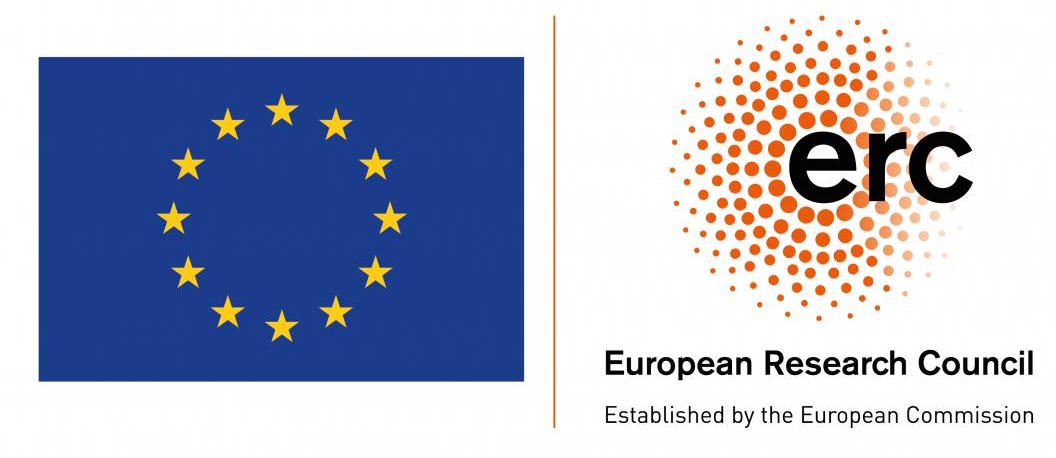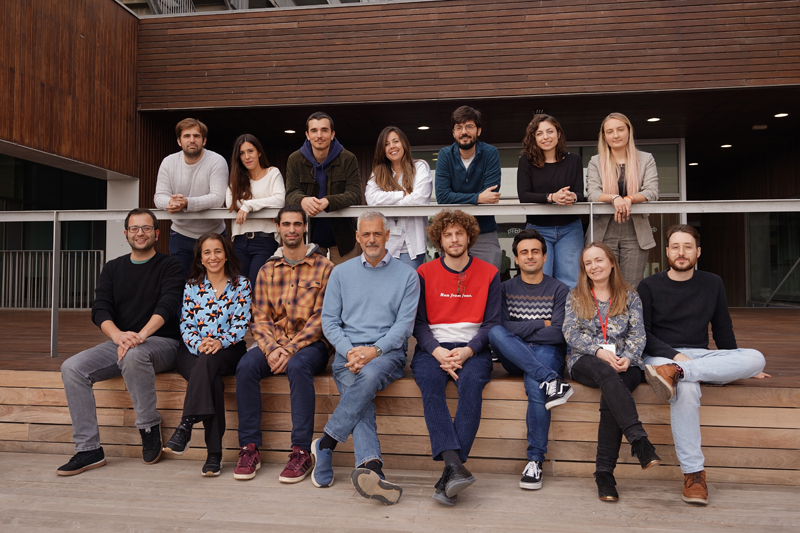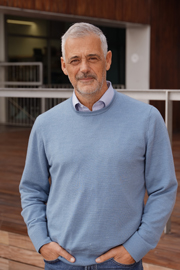 Serrano Lab
Serrano Lab
 Systems and Synthetic Biology
Systems and Synthetic Biology
- Group page
- Research lines
- Group members
- Publications
1981 Biology Sciences, Universidad Complutense de Madrid (Spain)
1982 Master of Sciences, Universidad Complutense de Madrid (Spain).
1985 Ph.D. in Biochemistry, Universidad Complutense de Madrid (Spain).
1987 Postdoctoral, Center of Mollecuar Biology (CSIC-UAM), Universidad Autónoma de Madrid (Spain).
1991 Postdoctoral, Cambridge University (Great Britain).
2001-2005 Head of Dpt., Dpt. Structural & Computational Biology, EMBL (Germany).
2005-present ICREA Research Professor and Group Leader at the Center for Genomic Regulation, Barcelona (Spain)
2005-June 2011 Coordinator of the Systems Biology Program at the Center for Genomic Regulation, Barcelona (Spain)
2006-2016 Director of the EMBL/CRG Systems Biology Research Unit at the Centre for Genomic Regulation, Barcelona (Spain)
July 2011-present Director of the Centre for Genomic Regulation, Barcelona (Spain)
News
Hundreds of new cancer driver genes predicted by algorithm (03/09/2024)
Researchers at the Centre for Genomic Regulation (CRG) have discovered hundreds of potential new cancer driver genes. The findings, published in the journal Nature Communications, significantly expands the list of possible therapeutic targets to monitor and tackle the disease.
Antibody design and cancer liquid biopsy research projects backed by ERC (11/07/2024)
Dr. Luis Serrano and Dr. Eva Novoa, researchers at the Centre for Genomic Regulation (CRG) in Barcelona, have each received a prestigious Proof of Concept (PoC) grant from the European Research Council in the first round of the 2024 competition.
Bacterial Protein Universe is Much Larger Than Expected (20/03/2024)
The bacterium Mycoplasma pneumoniae, one of the smallest known microbes and a mild disease-causing human pathogen, has 43% more genes than previously thought, according to the findings of a study published in the journal Nature Communications.
Luis Serrano Pubul, new Doctor Honoris Causa from the UMH (25/01/2024)
Luis Serrano receives the degree of Doctor honoris causa from the Miguel Hernández University of Elche (UMH).
CRG spin-off Orikine Bio closes 5.5 million euro seed financing round (18/07/2023)
Orikine Bio was co-founded by Dr. Luis Serrano, Dr. Ariadna Montero, Dr. Javier Delgado, Dr. Alejo Chorny and AdBio Partners in 2022. The company’s unique synthetic biology platform delivers optimized and novel engineered cytokines called Foldikines©.
‘Living medicine’ created to tackle drug-resistant lung infections (19/01/2023)
Researchers have designed the first ‘living medicine’ to treat lung infections. The treatment targets Pseudomonas aeruginosa, a type of bacteria which is naturally resistant to many types of antibiotics and is a common source of infections in hospitals.
ERC funds CRG ‘designer cytokine therapy’ project (24/05/2022)
Thanks to a new Proof of Concept Grant granted today by the European Research Council (ERC), CRG researchers led by Dr. Luis Serrano will explore new methods that improve the therapeutic effectiveness of cytokines.
Researchers create ‘living medicine’ to treat drug-resistant infections (06/10/2021)
Researchers at the Centre for Genomic Regulation (CRG) and Pulmobiotics S.L have created the first ‘living medicine’ to treat antibiotic-resistant bacteria growing on the surfaces of medical implants.
The CRG is recognised by the National Research Awards of Catalonia (02/07/2021)
This year, the Government of Catalonia and the FCRI have recognised the CRG for creating Pulmobiotics S.L, a preclinical company that uses synthetic biology to develop new treatments and vaccines for various types of lung diseases.
Three entrepreneurs selected for US State Department’s training programme (14/05/2021)
Ariadna Montero, a researcher at the Serrano lab, is also developing business ideas around synthetic biology, using software to design proteins that can be used for various therapeutic purposes.
ERC funds development of new treatments for lung disease (22/04/2021)
Funding will go towards engineering a bacterium to treat pulmonary fibrosis.
Viruses adapt to ‘language of human cells’ to hijack protein synthesis (17/03/2021)
Human viruses including SARS-CoV-2 are better adapted to infecting certain types of tissues based on this ability.
Ferrets, cats and civets most susceptible to coronavirus infection after humans (09/12/2020)
Knowing which animals are susceptible to SARS-CoV-2 prevents the building up animal reservoirs from which the coronavirus can re-emerge
Ramón Areces fellow, Xavier Hernández, recognised with national award (22/10/2020)
Xavier Hernández, PhD student in Luis Serrano's laboratory at the CRG, has received a Premio Nacional de Fin de Carrera de Educación Universitaria, granted by the Ministry of Education for having one of the top five science results among graduates statewide in 2016.
Charting metabolic maps in the pursuit of new vaccines and antimicrobials (02/06/2020)
A study in Cell Reports maps genes essential for the metabolic function of M. agalactiae and M. pneumoniae, two common bacteria that infect livestock and humans respectively
Pulmobiotics secures two-million-euro investment from Invivo Capital (14/04/2020)
Luis Serrano and Maria Lluch of the Centre for Genomic Regulation (CRG) in Barcelona have founded Pulmobiotics S.L., a pre-clinical life sciences company using synthetic biology to develop new treatments and vaccines for various types of lung diseases.
Designing multi-purpose vaccines: the MycoSynVac project concludes after five years (25/03/2020)
Scientists from the five-year EU funded project MycoSynVac report their findings and successes at a final meeting in Brussels.
Engineering bacteria to treat lung infection diseases (23/12/2019)
The lab of Luis Serrano was awarded a PRODUCTE grant, 2018 Knowledge Industry, from the Catalonian Government.
Salva a animales en ‘Battle for Cattle’, un videojuego de estrategia basado en un proyecto actual de investigación (18/12/2019)
Battle for Cattle es un nuevo y divertido juego de estrategia que te pone en la piel de un científico que intenta detener la propagación mortal de Mycoplasma en vacas causada por la resistencia a antibióticos.
Gene editing opens up the way for new treatments for currently incurable diseases (13/06/2019)
On 13 and 14 June, CosmoCaixa Barcelona will be hosting a meeting between researchers and the foremost international experts in synthetic biology, convened by B·Debate, an initiative of Biocat and “la Caixa”.
Revealing the role of the mysterious small proteins (22/02/2019)
CRG investigators develop a technique to identify and classify proteins with less than 100 amino acids
Luis Serrano presents synthetic vaccines at the European Parliament (27/11/2018)
European scientists come together in a public meeting in Brussels today to present and discuss how innovation improves the everyday life. MycoSynVac is one of the 16 H2020 funded projects featured in the conference.
You are the company you keep (25/10/2018)
Researchers at the Centre for Genomic Regulation (CRG) in Barcelona, Spain, have developed a new high-throughput screening method to detect direct biomolecule interactions.
Two CRG projects have been awarded ERC Proof of Concept grants (10/09/2018)
IMPACCT and MycoVAP projects both will receive ERC PoC grants to explore potential clinical applications of their recent results on breast cancer and pneumonia respectively. CRG group leaders Miguel Beato and Luis Serrano have both been awarded ERC Proof of Concept grants, worth €150,000 each. These grants are aimed at bridging the gap between pioneering basic research and the challenges during the early phases of its commercialisation.
New perspective on tumour genome evolution (12/07/2018)
An interdisciplinary team of scientists at the Centre for Genomic Regulation (CRG) deepens understanding of tumour genome evolution and suggests negative selection acting on cancer-essential genes plays a more important role than previously anticipated. Their work, published in Genome Biology, also provides new insights for improving cancer immunotherapies in the future.
This one goes up to 11: researchers crack code for genetic ‘control dials’ (06/09/2017)
Scientists at the Centre for Genomic Regulation (CRG) in Barcelona, Spain, have developed a new technique to crack the underlying DNA code for the ‘control dials’ that determine levels of gene activity in bacteria. The discovery has important implications for biotechnology, because genetically engineered bacteria and other organisms are used to produce useful molecules such as new materials and drugs.
Scientists reveal hidden structures in bacterial DNA (22/03/2017)
Researchers at the Centre for Genomic Regulation (CRG), have discovered previously unknown arrangements of DNA within extremely small bacteria, publishing their findings in the journal Nature Communications.
Summary
In our group we are aiming at a quantitative understanding of biological systems to an extent that one is able to predict systemic features and with the hope to rational design and modify their behaviour. This applies to any system comprising biological components that is more than the mere sum of its components, or, in other words, the addition of the individual components results in systemic properties that could not be predicted by considering the components individually. By achieving this objective we are aiming at new global understanding and treatment of human diseases in which the target will not be a single molecule but a network. For this purpose in our group we develop on one hand new software and theoretical approximations to understand complex systems and on the other we do experiments to validate our predictions.
You can find more information about our group and our research projects on our website
Relevant Grants

LUNG-BIOREPAIR
Project title: Engineering a lung bacteria to treat idiopatic lung fibrosis and other non-infectious lung diseases
Grant type: ERC Advanced Grant
EU Contribution: -
Start date (estimated): 01/11/2021 (60 months)
MycoVAP
Project Title: Bacterial chassis for treating ventilator-associated pneumonia (VAP)
Grant type: ERC Proof of Concept Grant
EU Contribution: 149,625 €
Start date: 01/01/2019
End date: 30/06/2020
MYCOCHASSIS
Project title: Engineering of a minimal bacterial therapeutic chassis
Grant type: ERC Advanced Grant
EU Contribution: 2,454,522 €
Start date: 01/11/2015
End date: 31/10/2021
MINICELL
Project title: A model-driven approach to minimal cell engineering for medical therapy
Coordinator: Luis Serrano
Call: ERANET-2014
EU Contribution: 1,730,903 €
Start date: 01/10/2015
End date: 30/09/2018
MYCOSYNVAC
Project title: Engineering Mycoplasma pneumoniae as a broad-spectrum animal vaccine
Coordinator: Luis Serrano
Call: LEIT-BIOTEC-2014
EU Contribution: 8,056,677 €
Start date: 01/04/2015
End date: 31/03/2020
Mico pLung
Project Title: “MycoBiotics” as a new technology platform for the treatment of human respiratory and genial tract diseases
Grant type: ERC Proof of Concept Grant
EU Contribution: 150,000 €
Start date: 01/07/2013
End date: 31/12/2014
CellDoctor
Project Title: Quantitative understanding of a living system and its engineering as a cellular organelle
Grant type: ERC Advanced Grant
EU Contribution: 2,400,000 €
Start date: 01/03/2009
End date: 28/02/2015
Technology Transfer Activities
Dr. Luis Serrano is founder of Diverdrugs, Cellzome, Triskel, En Vivo and Pulmobiotics and developer of FoldX software for protein design.
Funding acknowledgements


The "VEIS-Valorisation of EGA for Industry and Society" (VEIS-001-P-001647) project is cofunded by the European Regional Development Fund of the European Union in the framework of the ERDF Operative Program of Catalonia 2014-2020, with a grant of 1,951,429.38 EUR, with the support of the Department of Research and Universities of the Government of Catalonia.

The project "Ingenieria de Mycoplasma pneumoniae para el tratamiento de cáncer de pulmón" is funded by Agencia Estatal de Investigación (AEI), the Ministerio de Ciencia e Innovación and Fondo Europeo de Desarrollo Regional (FEDER). Official reference number: Proyecto PID2021-122341NB-I00 financiado por MCIN/ AEI /10.13039/501100011033/ y por FEDER Una manera de hacer Europa

The project "LactAs: desarrollo de un bioterapéutico vivo recombinante para el tratamiento del asma grave" is funded by Agencia Estatal de Investigación (AEI), the Ministerio de Ciencia e Innovación, Fondos Europeos NextGeneration and the Plan de Recuperación, Transformación y Resilencia. Official reference number: Proyecto CPP2021-008552 financiado por MCIN/AEI /10.13039/501100011033 y por la Unión Europea NextGenerationEU/PRTR.
There are no contents associated to this section. For further information about the group, please click on the 'Group page' tab or visit the lab website

Group Leader
Staff Scientist
Postdoctoral Researchers
PhD Students
Technicians
Staff Scientist
Postdoctoral Researchers
PhD Students
Technicians
A database for the prediction of protein-protein interactions of modular domains
Most of the structures and function of globular domains from the proteome are yet unknown. In order to get some information about the biological role of these domains, the development of a methodology for the modelling, prediction and localization of putative partners is of crucial importance since it can be of general applicability for any domain involved in protein-protein interactions.
ADAN is a database of putative ligands for the most well-known modular protein-protein interaction domains like SH3, PDZ, etc. Many of these domains have a large number of homologues of which only a small fraction has been crystallized and only limited number of ligands is known. Based on the known structures, the ADAN project creates full atomic models of unknown protein-ligand structures using the FoldX algorithm and predicts new putative binders. A querying function allows the user to input a polypeptide sequence and retrieve the putative binding segments for a particular domain.
ADAN results from the collaboration between the group of Luis Serrano, currently at the CRG in Barcelona and Gregorio Fernández, researcher from the Cellular and Molecular Biology Institute of the Miguel Hernández University in Elche, Alicante.
An algorithm for the prediction of the helical content of peptides
Agadir is a prediction algorithm based on the helix/coil transition theory. Agadir predicts the helical behaviour of monomeric peptides. It only considers short range interactions. Conditions such as pH, temperature and ionic strength are used in the calculation. Modifications of the termini are also allowed. Agadir is not a program to predict secondary structure of proteins.
A structural classification of protein fragments
BriX is a structural classification of protein fragments. The library comprises fragments ranging from 4 to 14 amino acids that are clustered against 6 different distance thresholds. This has lead to an alphabet of around 2000 frequently observed letters or structural classes per chain length. These classes are accessible through a search and a browse interface.
BriX is being developed by Joost Schymkowitz and Frederic Rousseau and their team at the SWITCH Laboratory of VIB in Brussels, Belgium, in collaboration with Luis Serrano and his team at the CRG in Barcelona, Spain.
For more information about this software, please click here.
An automatic protein design algorithm that can be used to rationally modify protein stability, change protein specificity and affinity and predict metal binding sites. It can also be used to design protein-DNA interactions
FoldX is a computer algorithm developed to provide a fast and quantitative estimation of the importance of the interactions contributing to the stability of proteins and protein complexes. The predictive power of the algorithm has been tested on a very large set of point mutants spanning most of the structural environments found in proteins, as well as on protein complexes and protein-DNA complexes of medical and biotechnological relevance. FoldX uses a full atomic description of the structure of the proteins. The different energy terms taken into account in FoldX have been weighted using empirical data obtained from protein engineering experiments.
FoldX is being developed by the group of Luis Serrano at the CRG in Barcelona, Spain, in collaboration with Joost Schymkowitz and Frederic Rousseau and their team at the SWITCH Laboratory of VIB in Brussels, Belgium.
MyMpn is an online resource devoted to studying the human pathogen Mycoplasma pneumoniae, a minimal bacterium causing lower respiratory tract infections.
SmartCell is a program developed to provide an idea of the evolution of a network in a whole, single cell.
SmartCell is a program developed to provide an idea of the evolution of a network in a whole, single cell. Based on stochastic algorithms, SmartCell needs multiple runs to have mean results. To help the user, SmartCell is distributed with a graphic user interface that allows for the creation of a model with a user friendly interface, as well as for the analysis and treatment of the results after the runs.
SmartCell is being developed by Luis Serrano and his team at the CRG in Barcelona.
A database for the molecular phenotyping of human SNPs and disease mutations
Single nucleotide polymorphisms (SNPs) are, together with copy number variation, the primary source of variation in the human genome. SNPs are associated with altered response to drug treatment, susceptibility to disease, and other phenotypic variation. Furthermore, during genetic screens for disease-associated mutations in groups of patients and control individuals, the distinction between disease causing mutations and polymorphisms is often unclear. Annotation of the functional and structural implications of single nucleotide changes thus provides valuable information to interpret and guide experiments.
SNPeffect is a database of non-synonymous SNPs and their predicted effect on the functional and physicochemical properties of the affected proteins. More precisely, SNPeffect analyses the effect of coding, non-synonymous SNPs on 3 categories of functional and physico-chemical properties of the affected proteins, namely protein structure and dynamics [stability, aggregation, dynamics, etc.], integrity of functional sites and cellular processing.
SNPeffect was originally developed by Joost Schymkowitz and Frederic Rousseau and their team at the SWITCH Laboratory of VIB in Brussels, Belgium, in collaboration with Luis Serrano and his team at the European Molecular Biology Laboratory in Heidelberg, Germany.
An algorithm for the prediction of aggregating regions in unfolded polypeptide chains
TANGO is a statistical mechanics computer algorithm developed for the prediction of aggregation nucleating regions in proteins, as well as of the effect of mutations and environmental conditions on the aggregation propensity of these regions.
TANGO is based on the physico-chemical principles of b-sheet formation extended by the assumption that the core regions of an aggregate are fully buried. TANGO was benchmarked against 175 peptides of over 20 proteins and was able to predict the sequences experimentally observed to contribute to the aggregation of these proteins. TANGO also correctly predicts the aggregation propensities of several disease-related mutations in the Alzheimer´s b-peptide, human lysozyme and transthyrethin, and discriminates between b-sheet tendency and aggregation.
The success of TANGO confirms the model of intermolecular b-sheet formation as a wide-spread underlying mechanism of protein aggregation and opens the possibility of screening large databases for potential disease-related aggregation motifs, as well as optimizing recombinant protein yields by rationally out-designing protein aggregation.
TANGO was originally developed by Luis Serrano and his team at the European Molecular Biology Laboratory in Heidelberg, Germany.
An algorithm for the prediction of amylogenic regions in protein sequences
We have developed the WALTZ algorithm for the identification of amyloid forming hexapeptides in amino acid sequences. WALTZ combines terms from amino acid sequence scoring in the learning set, physical property analysis and homology modelling. The method shows ~84% sensitivity at ~92% specificity on the AmylHex dataset, and correctly identifies mutations in human proteins known to be associated with amyloid deposition. The combination of the aggregation predicting algorithm TANGO with WALTZ, provides a complete cover of aggregation and amyloid tendency in protein sequences.
WALTZ is being developed by Joost Schymkowitz and Frederic Rousseau and their team at the SWITCH Laboratory of VIB in Brussels, Belgium, in collaboration with Luis Serrano and his team at the CRG in Barcelona, Spain.









